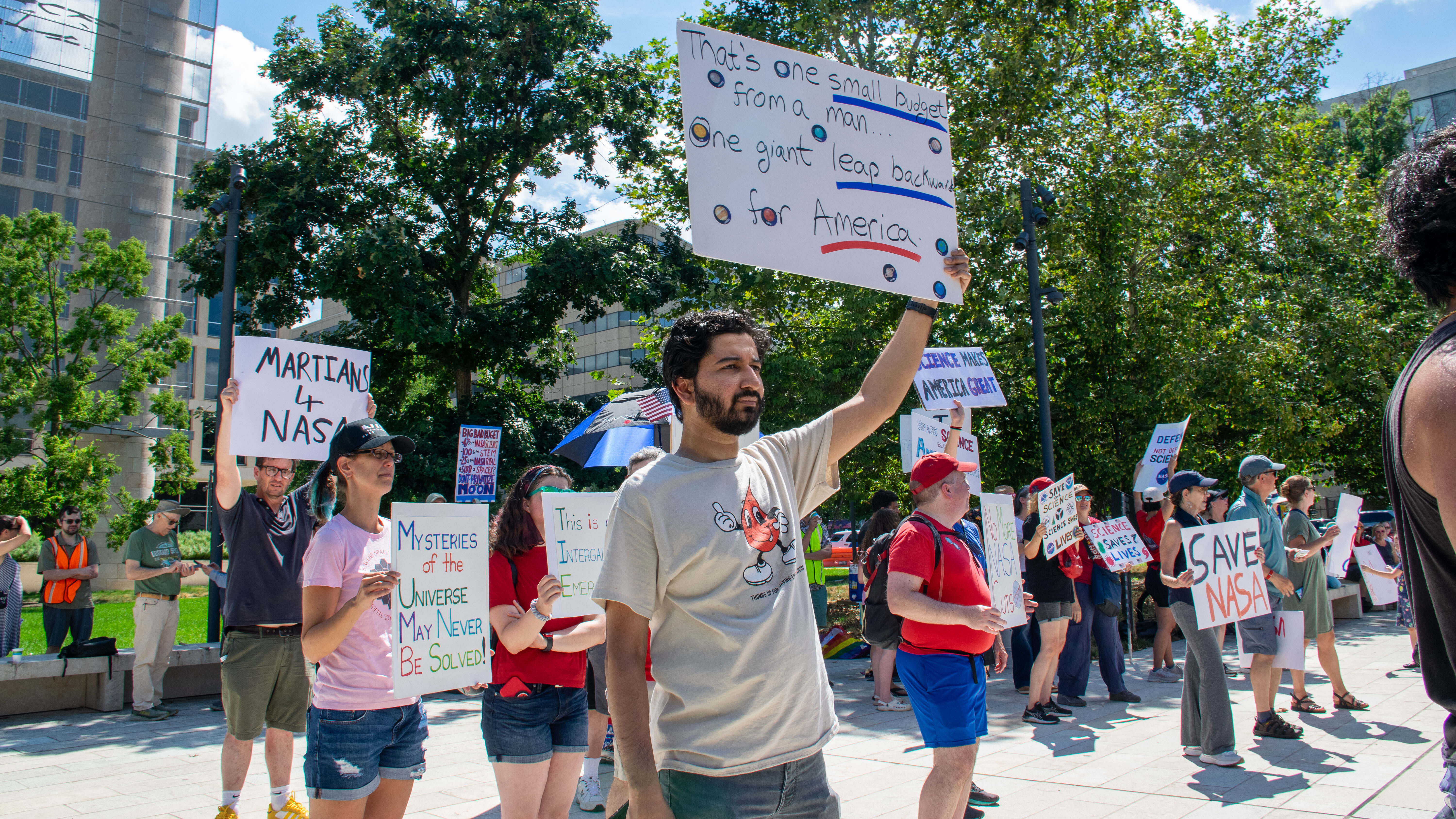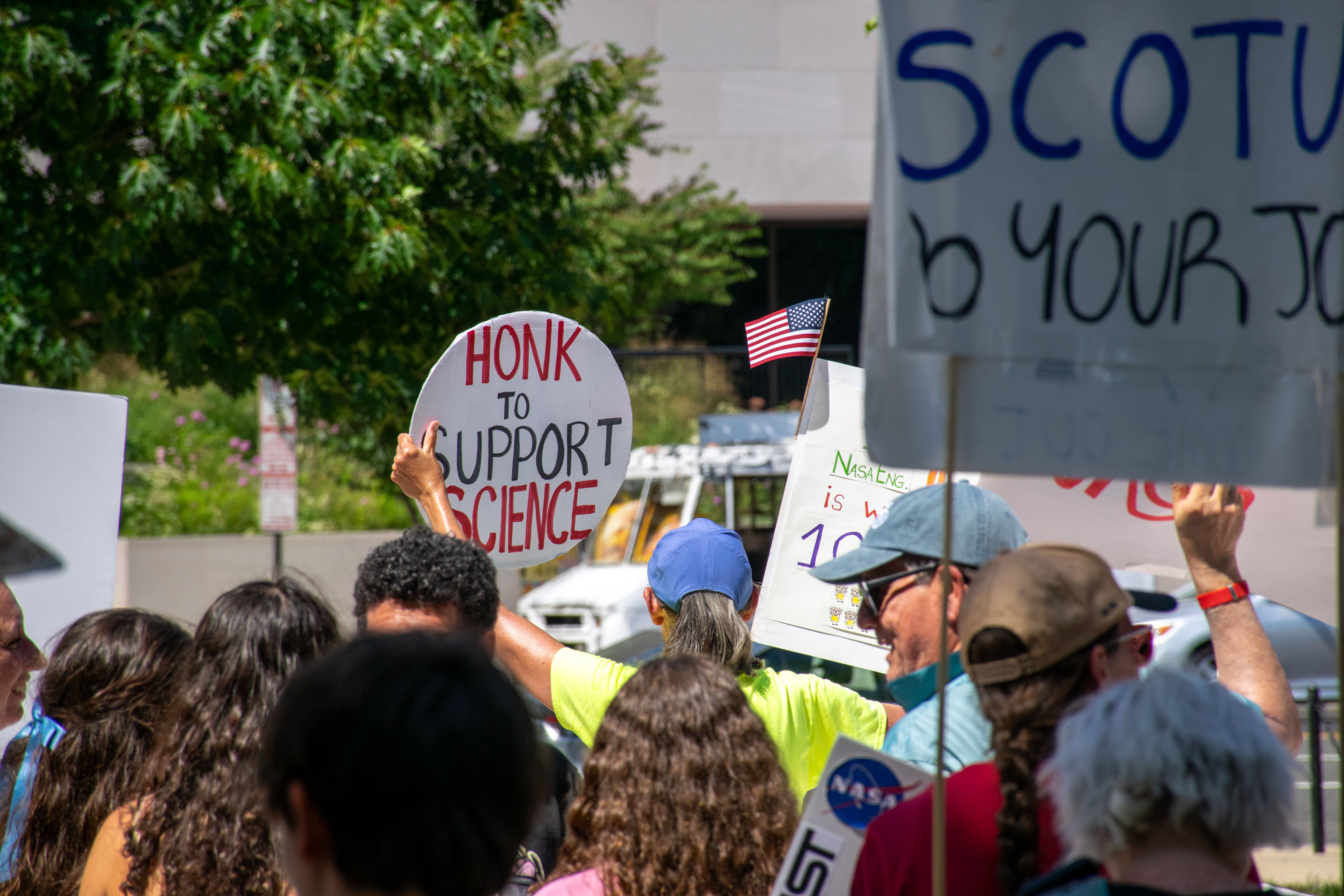WASHINGTON — NASA scientists and engineers are demanding Congress help turn down the heat on an agency whose current leadership, they say, is burning down American dominance in space and science.
A group of NASA employees, contractors, their families, friends and other supporters gathered across from the Smithsonian National Air and Space Museum on July 20 — the anniversary of humanity’s historic first landing on the moon. Nearly 100 showed up Sunday to protest deep budget cuts and mass layoffs within the nation’s space agency, and to urge Congress to take expedient action to reverse or minimize further losses.
“We are here because NASA is under attack,” said one of the protest’s organizers, NASA contract employee Marshall Finch. “And we are its defense.”
Just days earlier, lawmakers from the U.S. House of Representatives’ Committee on Science, Space, and Technology published a scathing letter to interim NASA Administrator Sean Duffy, accusing agency leadership of acting outside its legal authority by enacting extensive cuts before a final budget is passed.
Budget cuts
Protesters, including the ad hoc organizing group called NASA Needs Help, gathered to sound the alarm over what they view as broad, preemptive overcompliance with President Donald Trump’s 2026 budget proposal, which slashes NASA’s science portfolio by roughly 50% — a cut that would cancel more than 40 current and upcoming space missions. While the budget proposal continues to make its way through Congress, NASA officials at the very top of agency leadership seem to have already begun implementing cuts, notifying employees and contractors of impending reductions in force (RIFs) and encouraging people to take advantage of the government’s Deferred Resignation Program (DRP).
“They are telling everybody below them to take the Deferred Resignation Program now. To jump ship,” said Finch. “This is going to weaken NASA, and it’s going to weaken the United States.”
Congressional response
Reps. Zoe Lofgren (D-California) and Valerie Foushee (D-North Carolina) of the House Science Committee sent a letter to interim Administrator Duffy on July 16 in which they, too, expressed concern that the agency was treating Trump’s budget request as enacted law.
“It now appears that the agency intends to implement funding cuts that were never enacted by Congress in order to ‘align’ the agency’s present-day budget with the Trump Administration’s slash-and-burn proposed budget for the next fiscal year, with seemingly no concern for the devastation that will be caused by mass layoffs, widespread program terminations and the possible closure of critical centers and facilities,” the letter stated.
“A presidential budget request is just that: a request to Congress,” Lofgren and Foushee wrote in the letter. “The notion that any executive branch agency would unilaterally take steps to implement a budget proposal before its budget is enacted by Congress is therefore offensive to our constitutional system. It would be illegal.”

NASA is opting to keep the political back-and-forth between the agency and lawmakers, for the time being.
“NASA will handle legislative matters and letters from elected officials directly with the addressing parties,” NASA officials told Space.com in an emailed statement on July 23.
The space agency disputed one of the lawmakers’ claims — specifically, that NASA leadership had directed at-risk programs to cease public communications regarding mission accomplishments.
“The statement from House Democrats in their letter to Secretary Duffy, alleging that ‘NASA Chief of Staff Brian Hughes appears to have recently ordered scientific missions slated for termination in the FY26 PBR (fiscal year 2026 presidential budget request) to stop issuing press releases celebrating new results and scientific achievements,’ is unsubstantiated and untrue,” NASA Press Secretary Bethany Stevens told Space.com. “This is false and it is not the policy.”
NASA officials did not comment on other assertions made in the letter.

Protesters at the July 20 demonstration, which coincided with the 54th anniversary of NASA’s Apollo 11 moon landing in 1969, echoed Lofgren and Foushee’s concern. They worried that by the time Congress acts, the damage to NASA may be irreversible.
Congress is pushing back on the proposed cuts, with the Senate Appropriations Committee advancing a measure to fund NASA at a level comparable to fiscal year 2025, and there is apparent bipartisan support for maintaining the space agency’s science programs. But many who showed up at the demonstration worried that lawmakers’ actions may come too late.
“Congress says they want to save NASA,” Finch said. “Let’s see them do it now … Let’s see them fight.”
Growing fear
Meanwhile, protesters described a rising sense of fear and uncertainty within NASA. Many said they feel demoralized by mounting pressure to leave under the DRP and the abrupt departures of their colleagues who already have. As they watch many of their coworkers resign, protesters worry that critical institutional knowledge is leaving with them.
Julie, who, like other protesters interviewed by Space.com, asked that her full name be omitted, also helped organize the demonstration. She thinks these personnel losses could have deeper implications, and used NASA’s Office of the Chief Knowledge Officer as an example. “That was set up after (the) Columbia and Challenger (space shuttle disasters) to make sure that we were passing any lessons learned on to the entire community,” Julie explained.
“Watching all of this brain drain leave without any kind of backup plan at all, any kind of structure, has been just the most depressing thing. I can kind of see another Challenger, another Columbia happening down the road as a result of this, and it will ultimately be blamed back on us,” she told Space.com.
“That knowledge isn’t being passed on in any way. So we’re going to see the effects of that sooner rather than later,” Julie added. She was one of several protest attendees who voiced such sentiments, warning of potential disaster on par with the space shuttle accidents.

The droves of departures at NASA have also fueled some of the urgency that motivated many to attend the weekend’s demonstration.
“It’s been the hardest to watch all that knowledge slip away,” Julie said. “And that really kind of emboldens people to take a little bit of extra risk to come out with something like this on the weekend.”
Every protester who spoke at the demonstration, and with Space.com, on Sunday stressed that their actions and remarks were not representative of NASA or their respective contract employers. Even the planning for the July 20 event was carefully and purposefully done outside employees’ working hours, organizers said.
“A lot of people here, I think, are pretty scared of any blowback on them at work,” another protester, Will, told Space.com. Will indicated that he previously worked for NASA, or a NASA contractor, but that is no longer the case.
The internal climate at the space agency has undergone a dramatic shift this year, with a sense of suspicion guarding people’s interactions. “There’s a little bit more distrust than there was before, even within the community,” Julie said.

The majority of protesters in attendance Sunday work at NASA’s Goddard Space Flight Center in Maryland. Goddard is one of two space agency facilities in the D.C. area, the other being NASA Headquarters. NASA Needs Help organizers held their first protest outside the agency’s headquarters on June 30.
Uneasiness within the space agency is particularly evident at Goddard. Approximately 10,000 employees work at the Maryland facility, either through contractors or for NASA directly. In addition to program and workforce cuts in the White House budget proposal, “passback” documents sent to the space agency in April also suggest shuttering Goddard completely.
“Our management, our administration, is doing everything they can to break our will, to make us give up, to make us go do other things,” decried one NASA engineer, who asked to remain anonymous, during the protest. “I’m here today because I fear for our astronauts’ lives as we lose more and more expertise, and the technical expertise that we need to send them safely on their mission,” she said.
“Normally, supervisors say, ‘Stay, we need you. You’re an expert in your field. We want you to stay.’ But right now, the civil servants at the top — that is people like Brian Hughes, like Goddard Center (Director) Mackenzie Lystrup, many more names, they are telling everybody below them to take the Deferred Resignation Program now,” Finch told demonstrators.
NASA leadership
After nearly half a year of warnings about impending RIFs, some in management positions are beginning to take their own advice. According to a Politico report, over 2,000 senior leadership staff are expected to resign from the space agency to take advantage of the DRP initiatives. That includes aforementioned Goddard Center Director Mackenzie Lystrup.
One day after NASA employees held their protest, Lystrup announced her resignation. Her abrupt departure intensifies concerns about the state of NASA’s leadership, which currently seems more disjointed than ever.

This could be seen during an Artemis Accords ceremony on Thursday (July 24), at which the ambassador of Senegal and other Senegalese officials added their signatures to the growing list of countries committed to the safe, collaborative exploration of the moon and deep space.
Absent from those proceedings was interim NASA Administrator Duffy. Duffy was unexpectedly appointed to the post on July 9 through an announcement by Trump on his Truth Social platform. Duffy, who already serves as Secretary of Transportation, is now wearing both hats. Since his appointment, he has made no public remarks about his NASA role other than a small handful of supportive posts to a newly-created X account focused on his position at the space agency.
Prior to 2025, many Artemis Accord signing ceremonies included past NASA Administrators Bill Nelson or Jim Bridenstine. Rather than Duffy, NASA Chief of Staff Brian Hughes oversaw Senegal’s signing on Thursday. Also not in apparent attendance were Acting NASA Associate Administrator Vanessa Wyche and NASA Deputy Associate Administrator Casey Swails, both of whom, like Duffy, sit above Hughes in the NASA leadership hierarchy. Duffy did offer a retweet of NASA’s post on X about the event.
Today, following a July 9th meeting of Senegal President Bassirou Diomaye Faye with President Trump, the Senegalese Agency for Space Studies Miram Kaïré became the 56th signatory of the Artemis Accords At @NASA we’re proud to build on President Trump’s legacy of global… https://t.co/EBbunc6HUlJuly 24, 2025

Voyager Declaration
Circulating amongst NASA employees in the background leading up to the July 20 demonstration, another letter to Duffy communicated a similar message as that from the Committee on Science, Space, and Technology.
The Voyager Declaration was published July 21 as a formal statement protesting the proposed science cuts and preemptive actions already enacted by NASA leadership. The letter was signed by nearly 300 current and former NASA employees, 150 of whom chose to do so anonymously, “due to the culture of fear of retaliation cultivated by this administration,” the letter states.
“Major programmatic shifts at NASA must be implemented strategically so that risks are managed carefully,” it states. “Instead, the last six months have seen rapid and wasteful changes which have undermined our mission and caused catastrophic impacts on NASA’s workforce.” Their grievances were listed in the letter (included verbatim):
- We dissent to changes to NASA’s Technical Authority capacities that are driven by anything other than safety and mission assurance.
- We dissent to the closing out of missions for which Congress has appropriated funding.
- We dissent to implementing indiscriminate cuts to NASA science and aeronautics research.
- We dissent to NASA’s non-strategic staffing reductions.
- We dissent to canceling NASA participation in international missions.
- We dissent to the termination of NASA contracts and grants for reasons unrelated to performance.
- We dissent to the elimination of programs aimed at developing and supporting NASA’s workforce.

Public impact
Protesters at the July 20 demonstration warned of broader impacts that such substantial cuts could have on the public at large. NASA contract employees Justin and Madeline said they attended the protest to raise awareness about all the contributions to society that have come from NASA research and innovations.
“A lot of the stuff we have on Earth, like our cell phones, hurricane coverage, that’s all because of NASA. And defunding NASA means defunding all of that and making life worse for everyone,” Justin told Space.com. “And I don’t think a lot of people realize that.”
NASA employee Ben put much of NASA’s contributions into perspective by breaking down the numbers:
“In 2023-2024, for every dollar that NASA got in tax revenue, NASA generated $3 in economic output in the United States. Our actual budget was $25 billion and we generated $75 billion from that $25 billion. We generated 300,000 jobs across the country … And setting all of that aside, what about things you can’t put a price on?”
His $75 billion output figure, while a reasonable estimate, is not yet confirmed. NASA has not released full economic impact reports for 2023 or 2024.

Ben cited examples of NASA spinoff technology — advances in lasers developed by scientists building the James Webb Space Telescope are helping doctors perform eye surgeries on Earth, and innovations from the Hubble Space Telescope have contributed to mammogram imaging and technology used at hardware stores to match paint colors.
“None of this stuff even is accounted for in that three-to-one benefit that NASA generates directly to the economy,” Ben said. “Why, pray tell, in the name of efficiency, so called, is NASA the place you want to start slashing funding from?”
“There’s a lot of inventions that NASA has, if not created, at least catalyzed,” Will told Space.com. “If we zero out so many things, no longer are we going to have the great leap for mankind that Armstrong is so famously talking about.”
Human cost
Julie echoed those sentiments, highlighting not a mission, but a whole department on the chopping block: NASA’s Office of STEM Engagement (OSTEM). “OSTEM has been zeroed out completely,” she said. “That not only has an effect on what we do at NASA in terms of workforce development, but also kids across the entire country won’t have access to those programs, won’t have access to scholarships that let them go on to grad school and let them learn other things.”
“A lot of what NASA does is train teachers, so teachers can train students. And so, if that’s something that goes away completely, it’s going to impact the entire next generation of students.”
– Julie
Another protester, who asked to be identified only as “MC”, has worked as a teacher across a wide field of age ranges and learning abilities. “Every place I’ve ever taught, or every program I’ve ever supported — everybody needs science,” she said. “Every curriculum I’ve ever developed had science … Science of all kinds is incredibly important. And space — space is where we’re going.”
One protester, who identified herself as the mother of a NASA employee, stressed the value of empowering the next generation. “It’s very important that our kids have their dreams and reach those dreams,” she said. “If NASA is cut the way it is, STEM education is cut, science is cut, research is cut — we won’t have kids who have dreams anymore.”

George is part of a team responsible for testing spacecraft at Goddard. He attended Sunday’s protest alongside his wife and three daughters. “Goddard is looking at basically being shut down, and we have a whole bunch of people that know how to build individual, specific scientific spacecraft,” he told Space.com. “If we lose that (technical knowledge), it’s gone.”
“Where are we going to learn how to do that again?” George added. “Are we going to have to have another Challenger moment to learn how to do that again? Maybe.”
George’s daughters said they wanted to attend the protest to support their father. “It’s his job, so obviously that’s important to us,” his eldest, 15, said. But she’s also worried about what the future might look like if science takes a backseat at the space agency.
“I think that we should also be concerned about science over the future generations,” she said, calling the budget’s potential ramifications a “big loss.”
Job security is on the forefront of many NASA employees and contractors, many of whom have already received notice that their mission is at “high risk” of cancellation. Justin hasn’t received such a notice yet, but says the mission he works on studies climate change by measuring ice caps, “so I am assuming a couple things here,” he said.
That insecurity is already pushing some NASA scientists to look outside the agency. Amid potential layoffs, some are considering not just leaving the space agency, but the United States altogether. A lack of stability in the U.S. science community is opening the door for international recruitment.

“Right now, Europe and Asia, every other country in the world, sees what’s happening, and they’re extending offers,” Finch said to the crowd. “The next day, the members of the workforce are gone.”
Justin is still mulling over his options if his program gets canceled. But he came to a quick alignment with Madeline’s stance that she would “probably work for a different country that values science.”
“That would be the one,” Justin said in agreement.
Several European institutions have already begun reaching out to scientists and engineers across the U.S. to gauge people’s interest in continuing their work abroad. One representative said in an email obtained by Space.com that the responses to their initial outreach were “overwhelming (and worrying).”
With budget negotiations still ongoing in Congress, protesters are urging lawmakers to act before NASA loses the talent and infrastructure that made its past achievements possible.
“I don’t want to be a member of the first generation of humans that stops exploring,” Finch said. “We are not the ones who will suffer most — it is every generation of humans that will be set back by our abdication.”











